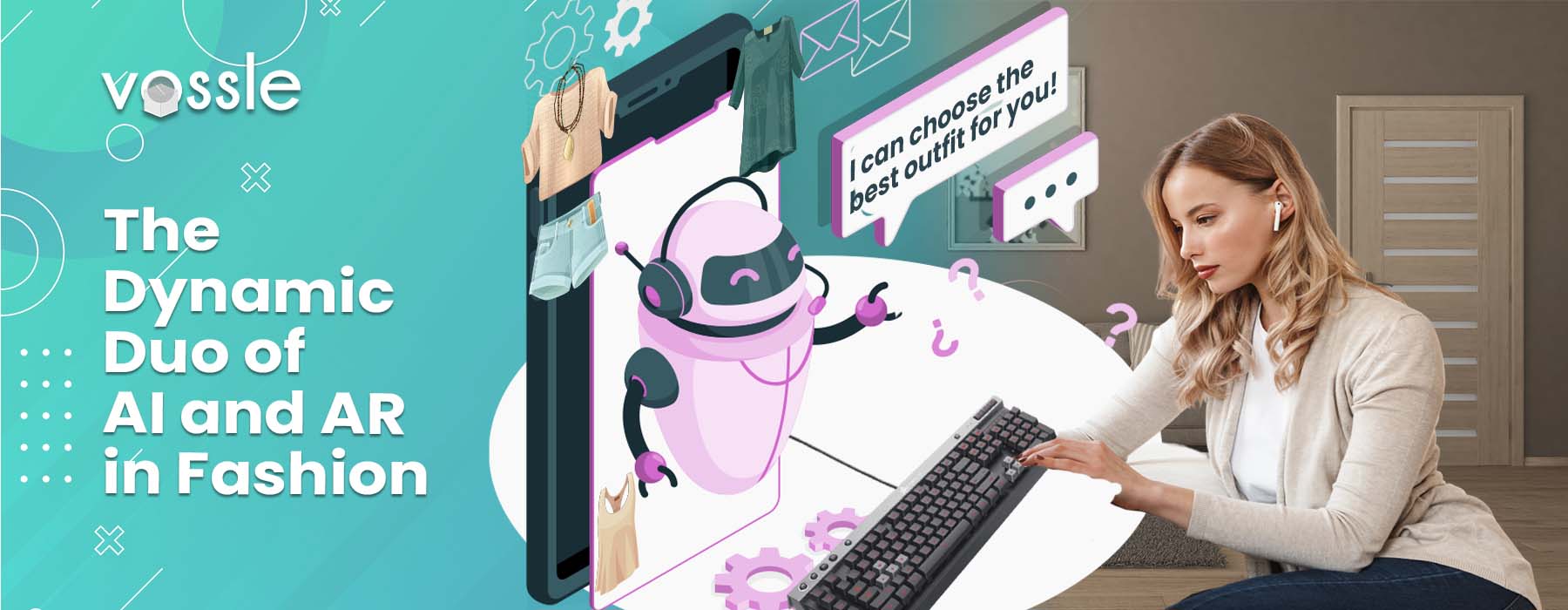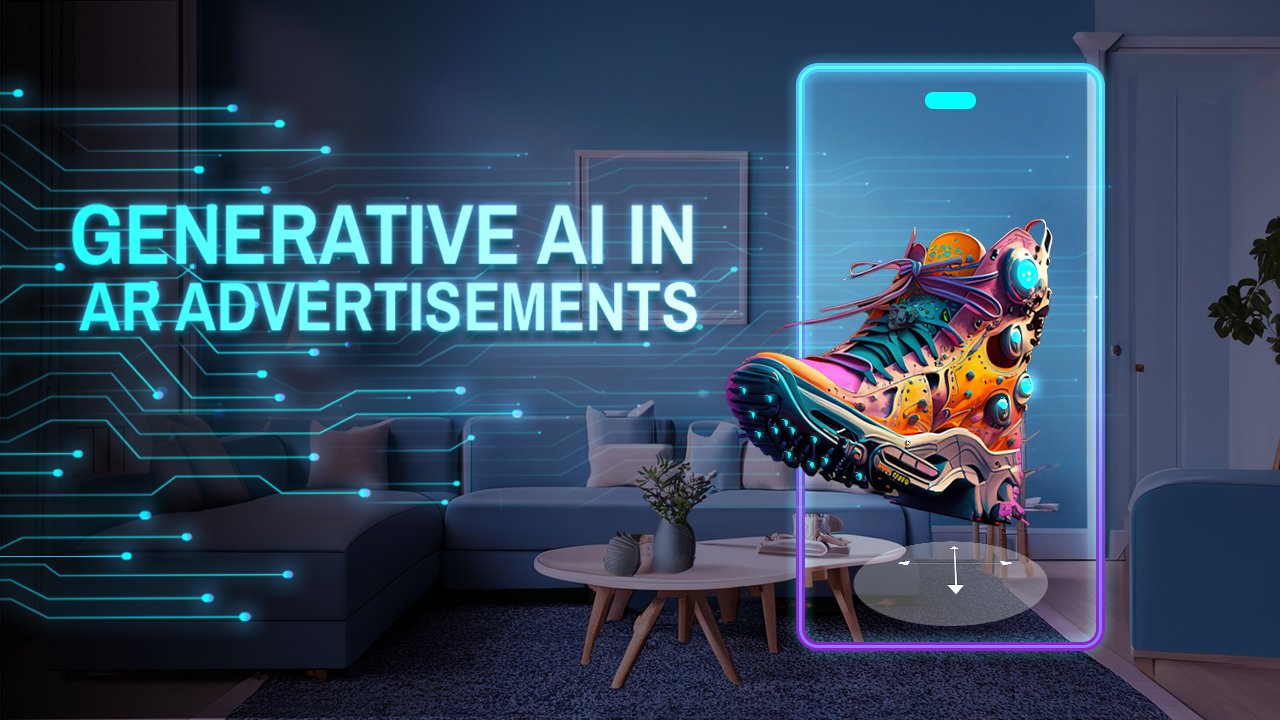According to a report by Grand View Research, the global AR market size was valued at USD 597.54 billion by 2030, registering a CAGR of 39.8% from 2023 to 2030. Experts suggest the use of AR in fashion industry as one of the key contributions to AR’s rapid growth, with applications such as virtual try-on, product visualization, and in-store experiences driving adoption.
Another report by Retail Perceptions found that 61% of consumers prefer to shop at stores that offer AR experiences and that 40% of consumers would pay more for a product if they could experience it through AR.
These statistics highlight the impact of AR on the fashion industry and the importance of adopting the technology to remain competitive and meet customer expectations.
Joining hands with AR, AI is revolutionizing technology that uses tons of volumes of data to analyze and assess the situation or problem and suggests smart solutions. AR is helping fashion businesses improve functioning such as better manufacturing and supply chain management, personalization, enhances design and product designing, and, the eternal hot topic, sustainable fashion.
We will explore how AI and AR in fashion are playing an impactful role in this blog. Plus, we will discuss the various reasons that AR and AI together give to businesses to hop onto the trend before their competitors take away all the windfall.
The Transformational Role of AR in Fashion Industry
To better understand the upcoming discussion let’s first brush up on what is this Augmented Reality we are talking about.
Augmented Reality or AR is an amazing immersive technology that blends virtual objects with the real world, creating an enhanced or augmented view of the physical environment.
The advancement in technology has made it handy and simple to use even by the most non-tech-savvy audience. All they need is to use the primary in-built of their smartphones, tablets, and smart glasses.
The technology will use the camera and other sensors to scan the environment and objects in the real world and overlay digital content, such as images, text, and animations, onto the real world.
AR technology works by detecting and tracking real-world objects or surfaces and then projecting virtual objects onto them. Users can interact with digital content as if it were a natural part of their physical environment.
The role of Augmented Reality (AR) is continuously increasing in the fashion industry. It is transforming the ways fashion businesses reach out to and engage their customers and offer an improved overall experience with their brand.
Fashion businesses can offer personalized experiences with AR through 3D product visualization and digital trials of their product. And users of this generation really expect personalized brand interaction and like brands that offer the same. Given that a whopping 80% of the consumer would engage with the company if it offers personalized experience and 90% say they find personalization appealing.
Let’s see how AR works on all these different aspects to help the business achieve its dream growth rate and business objectives.
3D Product Visualization and Virtual Tryon
AR technology enables businesses to let their customers virtually try on clothing and accessories. This gives them a better idea of how a particular product will look and fit them.
AR allows businesses to create virtual fitting rooms or mirror-like interfaces where customers can see themselves wearing various products. By using their smartphone or a dedicated AR device, customers can visualize how different items will look on them in real-time.
This immersive experience helps customers make more informed purchasing decisions by providing a better understanding of how a particular product will look and fit on their body.
Along the same lines, AR-based product visualization and VR tryons help users better understand the dimensions, and features of the product for higher purchase satisfaction and lesser product returns. Businesses can share the AR experience with their customers who can use their smartphone to place the product in their reality.
Given that most of the returns in online shopping are because the actual delivered products fail to match what consumers imagined at the time of purchase. Thereby, not only creating hassle for the customer, incurring unnecessary costs on the business but also training the brand image.
AR-based product tryons help mitigate this gap in the actual product and consumer expectations. Consumers can clearly see what they are going to get and this transparency leads to purchases and a positive brand image.
A Personalized Shopping Experience For More Sales
Another great role of AR in fashion is to offer a personalized shopping experience to consumers.
AR allows users to customize products as per their style and choice. They can modify color, fabric, and design virtually, resulting in a more personalized experience and increased customer engagement.
Consumers can also use AR to visualize how a product will look in different settings such as parties, sports, and streets as well as with different combinations of clothing. This brings a highly personalized experience that strikes a chord with the consumers.
Consumers appreciate the brand for their additional efforts to help customers make more informed purchasing decisions and increase their confidence in their choices.
Engaging Marketing and Branding Campaigns
AR in fashion is opening new and powerful ways of marketing and branding for businesses. AR helps fashion businesses create interactive and engaging content that captures the attention of customers and differentiates a brand from its competitors.
Businesses can use AR for interactive and immersive advertising campaigns that engage customers for longer sessions and improve brand awareness. Or they can create branded AR Social Media Filters that users can apply to their photos and videos. This provides a fun way for customers to engage with the brand and share their experiences with their social networks.
Another great application of AR in marketing and branding is AR Product Demos. AR can be used to create product demos that allow customers to see products in action and learn about their features and benefits in an interactive way. This can help to increase customer engagement and understanding of the product.
Enhanced In-Store Experience
AR is also used in physical stores to enhance the customer experience by providing them with additional product information and creating interactive displays. Such experiences engage and educate customers and build a connection with the brand.
Fashion businesses share information such as size and color options by overlaying this information onto physical products. For example, a customer could use their smartphone to scan a product and then see a virtual overlay of the different color and size options available.
Another add-on many fashion stores are utilizing is the interactive displays that allow customers to see how a product is made or to learn about the brand’s sustainability efforts.
Yet another interesting usage of AR in Fashion is Virtual Fitting Rooms. These AR-powered displays that engage and educate customers show the reflection of the customers with their chosen fashion wear that allows customers to try on clothes virtually. This reduces the need for physical try-ons, saves time, and increases convenience.
By adopting AR technology, fashion retailers can differentiate themselves, increase customer loyalty, and drive sales.
AI in Fashion: The best way to Sustainable Fashion

Artificial intelligence is a powerful technology that makes the computer smart to understand and analyze real-world problems by scanning a huge amount of data and then suggesting innovative solutions that till now evaded the human eye.
Along the same lines, Artificial Intelligence (AI) is increasingly being used in the fashion industry to enhance various aspects of the supply chain, from design and manufacturing to retail and customer experience.
As per Markets and Markets, the global AI in fashion market size is expected to grow from USD 228 million in 2019 to USD 1,260 million by 2024, at a Compound Annual Growth Rate (CAGR) of 40.8% during the forecast period.
Let’s see the different contributions of AI in the fashion industry.
Design and Product Development
AI analyzes customer data and the latest fashion trends to help fashion businesses in making informed design decisions and product development. It analyzes data from social media, e-commerce, and other sources to identify customer preferences, styles, and trends.
This can help fashion brands create products that better meet customer demands and reduce the risk of overproduction and waste.
Optimizing Manufacturing and Supply Chain
AI is also being used to optimize manufacturing and supply chain processes in the fashion space. For example, AI-powered systems analyze production data to identify inefficiencies and improve production processes, reduce costs, and increase sustainability.
Also, AI’s smart analysis improves inventory management, reduces waste, and improves the speed and accuracy of order fulfillment.
Personalized Customer Experience with Humanized Support
AI personalizes the customer experience and improves customer satisfaction. AI-powered systems can analyze customer data, such as purchase history and browsing behavior, to provide personalized recommendations and offer to the customer.
AI also improves customer service by providing instant and humanized customer support through smart chatbots and other automated systems.
For Sustainability Fashion
In a 2022 survey conducted by Statista, 35% of customers in the U.S. are willing to pay significantly more money if the clothing line is eco-friendly or sustainably produce
AI improves sustainability in the fashion industry by tracking and analyzing the environmental impact of production processes and identifying areas for improvement.
AI also optimizes supply chain logistics to reduce carbon emissions and improve resource efficiency.
The revolutionizing role of AI and AR in Fashion with examples
The fashion industry has been undergoing a transformation in recent years, with the integration of technologies such as Augmented Reality (AR) and Artificial Intelligence (AI). We have already discussed the major advantages of AI and AR in fashion in the above section.
However, there are instances when they closely work together to offer an even more engaging experience.
Multi-layered approach for the highest level of personalization
The technological combo brings the highest level of personalization to the customers of fashion businesses.
While AI churns out deeply analyzed and data-drive suggestions for the customers to suit their style, taste, and preferences, AR lets to add even more personalized touch through real-time customization and personalization of the fashion wear.
This helps customers make quicker yet better decisions with complete satisfaction. The result is fewer returns and a better brand image, not to mention saving cost and time and an increase in convenience.
Japanese men’s fashion brand Kashiyama used AR to offer a highly personalized experience to their customers.
Their online store allowed users to use AR and customize their suits in any way they want. Thereby, bringing a personalized experience that users like.
This not only helps the brand improve its brand image but also helps them understand customer preferences better and develop products according to lines based on demand.
AI Identifies and AR Overlays: A Deeply Immersive Experience
The combination of AI and AR helps offer a highly immersive experience wherein AI accurately identify the body part of the customer for AR to overlay digital object on the same.
To explain, It starts with AR capturing real-world images or video using the device’s camera. Then, AI, with the help of computer vision algorithms, analyzes the captured images or video and identifies the specified body part for which the fashionwear is meant along with other relevant information such as available size, color, stock, discount offers, related product, etc
Hence, AI-powered AR systems generate and overlay virtual objects or information that is contextually relevant and enhances the user’s experience.
Gucci, the Italian high-end luxury fashion house designed a pair of neon-colored, digital-only trainers, named The Gucci Virtual 25, that people can try on using AR using their smartphones, click a photo and share on social media.
AR and AI for More Sustainable Fashion
The fashion industry is one of the most environmentally damaging industries in the world, with a significant impact on natural resources, energy consumption, and pollution. However, the use of AR and AI technologies in the fashion industry can help address some of these environmental issues.
AR technology allows customers to virtually try on clothes, reducing the need for physical try-ons. This decreases the amount of clothing produced, which in turn reduces waste. Additionally, it can reduce the carbon footprint associated with shipping clothes back and forth to customers who need to return items due to improper fit.
Next, As we saw above, AI technology helps fashion companies optimize their supply chains, thereby, reducing the amount of unsold inventory and waste, which in turn reduces the amount of clothing that ends up in landfills. Additionally, AI is also used to optimize fabric cutting to reduce waste and maximize the use of materials.
Conclusion
In conclusion, AI and AR are two rapidly evolving technologies that have the potential to revolutionize the fashion industry. These technologies are being used to enhance the customer experience, improve personalization, increase efficiency, and promote sustainability.
AR is being used to provide customers with virtual try-on experiences and interactive displays, reducing the need for physical try-ons and enhancing the shopping experience. Additionally, AR is being used in marketing campaigns and branded content, providing a unique and immersive experience that differentiates brands from their competitors.
AI is being used to optimize supply chains, reduce waste, and increase efficiency. Fashion companies are using AI to predict customer demand and adjust production accordingly, reducing the amount of unsold inventory and waste. AI is also being used to create personalized recommendations for customers and to promote the use of recycled and reused materials.
Overall, the integration of AI and AR in the fashion industry is expected to bring about significant changes and innovations, improving the industry’s sustainability, efficiency, and competitiveness.



















